| Listing 1 - 10 of 28 | << page >> |
Sort by
|
Book
ISBN: 9783030030346 9783030030353 3030030342 3030030350 Year: 2019 Publisher: Cham Springer International Publishing :Imprint: Springer
Abstract | Keywords | Export | Availability | Bookmark
 Loading...
Loading...Choose an application
- Reference Manager
- EndNote
- RefWorks (Direct export to RefWorks)
This book addresses what software architects and developers need to know in order to build applications based on blockchain technology, by offering an architectural view of software systems that make beneficial use of blockchains. It provides guidance on assessing the suitability of blockchain, on the roles blockchain can play in an architecture, on designing blockchain applications, and on assessing different architecture designs and tradeoffs. It also serves as a reference on blockchain design patterns and design analysis, and refers to practical examples of blockchain-based applications. The book is divided into four parts: Part I provides a general introduction to the topic and to existing blockchain platforms including Bitcoin, Ethereum, and Hyperledger Fabric, and offers examples of blockchain-based applications. Part II focuses on the functional aspects of software architecture, describing the main roles blockchain can play in an architecture, as well as its potential suitability and design process. It includes a catalogue of 15 design patterns and details how to use model-driven engineering to build blockchain-based applications. Part III covers the non-functional aspects of blockchain applications, which are cross-cutting concerns including cost, performance, security, and availability. Part IV then presents three detailed real-world use cases, offering additional insights from a practical perspective. An epilogue summarizes the book and speculates on the role blockchain and its applications can play in the future. This book focusses on the bigger picture for blockchain, covering the concepts and technical considerations in the design of blockchain-based applications. The use of mathematical formulas is limited to where they are critical. This book is primarily intended for developers, software architects and chief information officers who need to understand the basic technology, tools and methodologies to build blockchain applications. It also provides students and researchers new to this field an introduction to this hot topic.
Programming --- Computer architecture. Operating systems --- blockchain --- bitcoin --- software engineering --- Software engineering. --- Application software. --- Computer security. --- Data protection. --- Software Engineering. --- Information Systems Applications (incl. Internet). --- Systems and Data Security. --- Security.
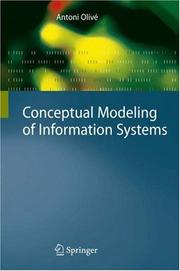
ISBN: 3642072569 3540393897 9783540393894 3540393900 3450393897 Year: 2007 Publisher: Berlin ; Heidelberg : Springer,
Abstract | Keywords | Export | Availability | Bookmark
 Loading...
Loading...Choose an application
- Reference Manager
- EndNote
- RefWorks (Direct export to RefWorks)
When designing an information system, conceptual modeling is the activity that elicits and describes the general knowledge the system needs to know. This description, called the conceptual schema, is necessary in order to develop an information system. Recently, many researchers and professionals share a vision in which the conceptual schema becomes the only important description to be created, as the system implementation will be automatically constructed from its schema – this is e.g. the basic idea behind OMG’s Model Driven Architecture. Olivé’s textbook explains in detail the principles of conceptual modeling independently from particular methods and languages and shows how to apply them in real-world projects. He covers all aspects of the engineering process from structural modeling over behavioral modeling to meta-modeling, and completes the presentation with an extensive case study based on the osCommerce system, an online store-management software program freely available under the GNU General Public License. His presentation is based on well-known industry standards like UML and OCL as a particular conceptual modeling language, yet also delivers the basics of the formal logical language background. Written for computer science students in classes on information systems modeling as well as for professionals feeling the need to formalize their experiences or to update their knowledge, Olivé delivers here a comprehensive treatment of all aspects of the modeling process. His book is complemented by lots of exercises and additional online teaching material.
Database design. --- System design. --- Database design --- System design --- Computer Science --- Engineering & Applied Sciences --- Design, System --- Systems design --- Data base design --- Computer science. --- Software engineering. --- Computers. --- Computer engineering. --- Computer Science. --- Computer Engineering. --- Information Systems Applications (incl. Internet). --- Models and Principles. --- Software Engineering. --- System Design --- Electronic data processing --- System analysis --- Bases de données --- Systèmes, Conception de --- Conception --- EPUB-LIV-FT LIVINFOR SPRINGER-B --- Computer software engineering --- Engineering --- Informatics --- Science --- 005.74
Book
ISBN: 364245397X 3642453988 9783642453977 Year: 2014 Publisher: Heidelberg [Germany] : Springer,
Abstract | Keywords | Export | Availability | Bookmark
 Loading...
Loading...Choose an application
- Reference Manager
- EndNote
- RefWorks (Direct export to RefWorks)
During the last few years, software evolution research has explored new domains such as the study of socio-technical aspects and collaboration between different individuals contributing to a software system, the use of search-based techniques and meta-heuristics, the mining of unstructured software repositories, the evolution of software requirements, and the dynamic adaptation of software systems at runtime. Also more and more attention is being paid to the evolution of collections of inter-related and inter-dependent software projects, be it in the form of web systems, software product families, software ecosystems, or systems of systems. With this book, the editors present insightful contributions on these and other domains currently being intensively explored, written by renowned researchers in the respective fields of software evolution. Each chapter presents the state of the art in a particular topic, as well as the current research, available tool support, and remaining challenges. The book is complemented by a glossary of important terms used in the community, a reference list of nearly 1,000 papers and books, and tips on additional resources that may be useful to the reader (reference books, journals, standards and major scientific events in the domain of software evolution, and datasets). This book is intended for all those interested in software engineering, and more particularly, software maintenance and evolution. Researchers and software practitioners alike will find in the contributed chapters an overview of the most recent findings, covering a broad spectrum of software evolution topics. In addition, it can also serve as the basis of graduate or postgraduate courses on e.g., software evolution, requirements engineering, model-driven software development or social informatics.
Application software. --- Component software. --- Computer science. --- Information Systems. --- Software engineering. --- Computer software --- Software engineering --- Engineering & Applied Sciences --- Computer Science --- Development --- Computer software engineering --- Management information systems. --- Computer Science. --- Software Engineering. --- Management of Computing and Information Systems. --- Information Systems Applications (incl. Internet). --- Engineering --- Application computer programs --- Application computer software --- Applications software --- Apps (Computer software) --- Informatics --- Science --- Computer-based information systems --- EIS (Information systems) --- Executive information systems --- MIS (Information systems) --- Sociotechnical systems --- Information resources management --- Management --- Communication systems --- Computer software - Development --- Software Engineering --- Development.
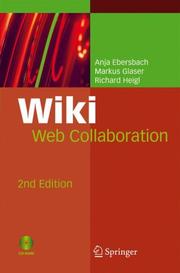
ISBN: 1281493686 9786611493684 3540681736 3540351507 9783540351504 Year: 2008 Publisher: Berlin ; [New York] : Springer,
Abstract | Keywords | Export | Availability | Bookmark
 Loading...
Loading...Choose an application
- Reference Manager
- EndNote
- RefWorks (Direct export to RefWorks)
About the authors Anja Ebersbach is an information scientist. She is a university and technical college instructor, and is also active as a freelance IT trainer. She is working on her dissertation on the topic of "Wikis as Tools of Scientific Work." Markus Glaser, also an information scientist, primarily works as a web and application programmer, where he specializes in MediaWiki and TWiki systems. Dr. Richard Heigl, a historian, works as a freelance instructor, IT trainer and moderator of large group seminars. He is primarily occupied with the planning and moderation of wiki projects. Alexander Warta, information scientist, is a doctoral candidate employed at Robert Bosch GmbH in Stuttgart. He is a specialist for the wiki software Confluence. Wiki – Web Collaboration Wikis are Web-based applications that allow all users not only to view pages but also to change them. The success of the Internet encyclopedia Wikipedia has drawn increasing attention from private users, small organizations and enterprises to the various possible uses of wikis. Their simple structure and straightforward operation make them a serious alternative to expensive content management systems and also provide a basis for many applications in the area of collaborative work. We show the practical use of wikis in carrying out projects for users as well as for maintainers. This includes a step-by-step introduction to wiki philosophy, social effects and functions, a survey of their controls and components, and the installation and configuration of the wiki clones MediaWiki, TWiki and Confluence. In order to exemplify the possibilities of the software, we use it as a project tool for planning a conference. Features and Benefits Introduces three of the most popular wiki engines Explores the wealth of possibilities with task oriented examples Provides an overview of social and philosophical issues Includes a CD containing all relevant open source software.
Web sites --- Wikis (Computer science) --- Authoring programs. --- WikiForums --- WikiWikiWebs --- Forums (Discussion and debate) --- Social media --- Authoring programs for Web sites --- Design --- Computer programs --- Software --- Multimedia systems. --- Natural language processing (Computer science). --- Computer science. --- Information Systems Applications (incl. Internet). --- Multimedia Information Systems. --- Natural Language Processing (NLP). --- Media Design. --- Informatics --- Science --- NLP (Computer science) --- Artificial intelligence --- Electronic data processing --- Human-computer interaction --- Semantic computing --- Computer-based multimedia information systems --- Multimedia computing --- Multimedia information systems --- Multimedia knowledge systems --- Information storage and retrieval systems --- Application software. --- Multimedia information systems. --- Multimedia systems . --- Application computer programs --- Application computer software --- Applications software --- Apps (Computer software) --- Computer software --- Web sites - Authoring programs
Book
ISBN: 3642366538 3642431844 3642366546 9783642366536 Year: 2013 Publisher: Heidelberg ; New York : Springer,
Abstract | Keywords | Export | Availability | Bookmark
 Loading...
Loading...Choose an application
- Reference Manager
- EndNote
- RefWorks (Direct export to RefWorks)
Domain engineering is a set of activities intended to develop, maintain, and manage the creation and evolution of an area of knowledge suitable for processing by a range of software systems. It is of considerable practical significance, as it provides methods and techniques that help reduce time-to-market, development costs, and project risks on one hand, and helps improve system quality and performance on a consistent basis on the other. In this book, the editors present a collection of invited chapters from various fields related to domain engineering. The individual chapters present state-of-the-art research and are organized in three parts. The first part focuses on results that deal with domain engineering in software product lines. The second part describes how domain-specific languages are used to support the construction and deployment of domains. Finally, the third part presents contributions dealing with domain engineering within the field of conceptual modeling. All chapters utilize a similar terminology, which will help readers to understand and relate to the chapters content. The book will be especially rewarding for researchers and students of software engineering methodologies in general and of domain engineering and its related fields in particular, as it contains the most comprehensive and up-to-date information on this topic.
Computer programming. --- Computer science. --- Computer simulation. --- Computer software -- Reusability -- Congresses. --- Software engineering. --- Software engineering --- Domain-specific programming languages --- Engineering & Applied Sciences --- Computer Science --- Computers --- Electronic computer programming --- Electronic data processing --- Electronic digital computers --- Programming (Electronic computers) --- Computer software engineering --- Programming --- Computer Science. --- Software Engineering. --- Information Systems Applications (incl. Internet). --- Simulation and Modeling. --- Engineering --- Coding theory --- Computer modeling --- Computer models --- Modeling, Computer --- Models, Computer --- Simulation, Computer --- Electromechanical analogies --- Mathematical models --- Simulation methods --- Model-integrated computing --- Líneas de Productos Software (40154304) --- Bibliografía recomendada --- Application software. --- Application computer programs --- Application computer software --- Applications software --- Apps (Computer software) --- Computer software --- Software Engineering --- Domain-specific programming languages.
Book

ISBN: 3319099302 3319099310 9783319099309 Year: 2014 Publisher: Cham Springer
Abstract | Keywords | Export | Availability | Bookmark
 Loading...
Loading...Choose an application
- Reference Manager
- EndNote
- RefWorks (Direct export to RefWorks)
This book provides the most complete formal specification of the semantics of the Business Process Model and Notation (BPMN) 2.0 standard available to date, in a style that is easily understandable for a wide range of readers – not only for experts in formal methods, but e.g. also for developers of modeling tools, software architects, or graduate students specializing in business process management. BPMN – issued by the Object Management Group – is a widely used standard for business process modeling. However, major drawbacks of BPMN include its limited support for organizational modeling, its only implicit expression of modalities, and its lack of integrated user interaction and data modeling. Further, in many cases the syntactical and, in particular, semantic definitions of BPMN are inaccurate, incomplete or inconsistent. The book addresses concrete issues concerning the execution semantics of business processes and provides a formal definition of BPMN process diagrams, which can serve as a sound basis for further extensions, i.e., in the form of horizontal refinements of the core language. To this end, the Abstract State Machine (ASM) method is used to formalize the semantics of BPMN. ASMs have demonstrated their value in various domains, e.g. specifying the semantics of programming or modeling languages, verifying the specification of the Java Virtual Machine, or formalizing the ITIL change management process. This kind of improvement promotes more consistency in the interpretation of comprehensive models, as well as real exchangeability of models between different tools. In the outlook at the end of the book, the authors conclude with proposing extensions that address actor modeling (including an intuitive way to denote permissions and obligations), integration of user-centric views, a refined communication concept, and data integration.
Management information systems. --- Workflow --- Business --- Management. --- Data processing --- Computer-based information systems --- EIS (Information systems) --- Executive information systems --- MIS (Information systems) --- Computer science. --- Industrial management. --- Software engineering. --- Application software. --- Computer Science. --- Software Engineering. --- Information Systems Applications (incl. Internet). --- Business Process Management. --- Computer Appl. in Administrative Data Processing. --- Sociotechnical systems --- Information resources management --- Management --- Communication systems --- Information systems. --- Computer software engineering --- Engineering --- Business administration --- Business enterprises --- Business management --- Corporate management --- Corporations --- Industrial administration --- Management, Industrial --- Rationalization of industry --- Scientific management --- Industrial organization --- Application computer programs --- Application computer software --- Applications software --- Apps (Computer software) --- Computer software --- Information systems --- Computer. Automation
Book
ISBN: 3662465310 3662465302 9783662465301 Year: 2015 Publisher: Berlin, Heidelberg : Springer Berlin Heidelberg : Imprint: Springer,
Abstract | Keywords | Export | Availability | Bookmark
 Loading...
Loading...Choose an application
- Reference Manager
- EndNote
- RefWorks (Direct export to RefWorks)
This book presents a comprehensive and systematic introduction to transforming process-oriented data into information about the underlying business process, which is essential for all kinds of decision-making. To that end, the authors develop step-by-step models and analytical tools for obtaining high-quality data structured in such a way that complex analytical tools can be applied. The main emphasis is on process mining and data mining techniques, and the combination of these methods for process-oriented data. After a general introduction to the business intelligence (BI) process and its constituent tasks in chapter 1, chapter 2 discusses different approaches to modeling in BI applications. Chapter 3 is an overview and provides details of data provisioning, including a section on big data. Chapter 4 tackles data description, visualization, and reporting. Chapter 5 introduces data mining techniques for cross-sectional data. Different techniques for the analysis of temporal data are then detailed in Chapter 6. Subsequently, chapter 7 explains techniques for the analysis of process data, followed by the introduction of analysis techniques for multiple BI perspectives in chapter 8. The book closes with a summary and discussion in chapter 9. Throughout the book, (mostly open source) tools are recommended, described, and applied; a more detailed survey on tools can be found in the appendix, and a detailed code for the solutions together with instructions on how to install the software used can be found on the accompanying website. Also, all concepts presented are illustrated and selected examples and exercises are provided. The book is suitable for graduate students in computer science, and the dedicated website with examples and solutions makes the book ideal as a textbook for a first course in business intelligence in computer science or business information systems. Additionally, practitioners and industrial developers who are interested in the concepts behind business intelligence will benefit from the clear explanations and many examples.
Data mining. --- Management information systems. --- Information systems. --- Data Mining and Knowledge Discovery. --- Business Information Systems. --- Computer Appl. in Administrative Data Processing. --- Information Systems Applications (incl. Internet). --- Business Process Management. --- Algorithmic knowledge discovery --- Factual data analysis --- KDD (Information retrieval) --- Knowledge discovery in data --- Knowledge discovery in databases --- Mining, Data --- Database searching --- Computer-based information systems --- EIS (Information systems) --- Executive information systems --- MIS (Information systems) --- Sociotechnical systems --- Information resources management --- Management --- Communication systems --- Business intelligence --- Data processing. --- Application software. --- Industrial management. --- Business administration --- Business enterprises --- Business management --- Corporate management --- Corporations --- Industrial administration --- Management, Industrial --- Rationalization of industry --- Scientific management --- Business --- Industrial organization --- Application computer programs --- Application computer software --- Applications software --- Apps (Computer software) --- Computer software
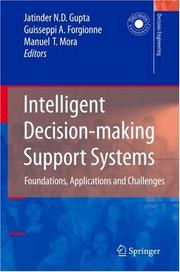
ISBN: 1280817313 9786610817313 1846282314 1846282284 1849965625 9781849965620 Year: 2006 Publisher: London : Springer,
Abstract | Keywords | Export | Availability | Bookmark
 Loading...
Loading...Choose an application
- Reference Manager
- EndNote
- RefWorks (Direct export to RefWorks)
Decision-making Support Systems (DMSS) are computer-based systems that support individual or organisational decision-making processes. Recent advances in information technology and artificial intelligence are enhancing these systems and giving rise to intelligent-DMSS. Intelligent Decision-making Support Systems: Foundations, Applications and Challenges is the first book to provide integrated coverage of the technical aspects of intelligent Decision-Making Support Systems together with discussion of their application and evaluation in organisational structures. The book brings together up-to-date information on the theory and application of i-DMSS. Readers will learn about the foundations, architectures, methods and strategies for successfully designing, developing, implementing, and evaluating intelligent Decision-making Support Systems. Intelligent Decision-making Support Systems: Foundations, Applications and Challenges will be of value to researchers in AI and management studies interested in the latest thinking in decision-making, as well practising managers and consultants who are involved with putting advanced information technologies into practice in organisations. The Decision Engineering series focuses on the foundations and applications of tools and techniques related to decision engineering, and identifies their relevance in ‘engineering’ decisions. The series provides an aid to practising professionals and applied researchers in the development of tools for informed operational and business decision making, within industry, by utilising distributed organisational knowledge.
Engineering economy. --- Operations research. --- Artificial intelligence. --- Engineering Economics, Organization, Logistics, Marketing. --- Operations Research/Decision Theory. --- Artificial Intelligence (incl. Robotics). --- Information Systems Applications (incl. Internet). --- AI (Artificial intelligence) --- Artificial thinking --- Electronic brains --- Intellectronics --- Intelligence, Artificial --- Intelligent machines --- Machine intelligence --- Thinking, Artificial --- Bionics --- Cognitive science --- Digital computer simulation --- Electronic data processing --- Logic machines --- Machine theory --- Self-organizing systems --- Simulation methods --- Fifth generation computers --- Neural computers --- Operational analysis --- Operational research --- Industrial engineering --- Management science --- Research --- System theory --- Economy, Engineering --- Engineering economics --- Decision support systems. --- Management information systems --- Telematics --- Artificial Intelligence. --- Engineering economics. --- Decision making. --- Application software. --- Application computer programs --- Application computer software --- Applications software --- Apps (Computer software) --- Computer software --- Deciding --- Decision (Psychology) --- Decision analysis --- Decision processes --- Making decisions --- Management --- Management decisions --- Choice (Psychology) --- Problem solving --- Decision making
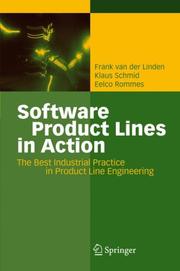
ISBN: 1280937300 9786610937301 3540714375 3540714367 3642090613 9783540714361 Year: 2007 Publisher: Berlin ; New York : Springer,
Abstract | Keywords | Export | Availability | Bookmark
 Loading...
Loading...Choose an application
- Reference Manager
- EndNote
- RefWorks (Direct export to RefWorks)
Software product lines represent perhaps the most exciting paradigm shift in software development since the advent of high-level programming languages. Nowhere else in software engineering have we seen such breathtaking improvements in cost, quality, time to market, and developer productivity, often registering in the order-of-magnitude range. While the underlying concepts are straightforward enough – building a family of related products or systems by planned and careful reuse of a base of generalized software development assets – the devil can be in the details, as successful product line practice can involve organizational change, business process change, and technology change. The authors ideally combine academic research results with industrial real-world experiences, thus presenting a broad view on product line engineering so that both managers and technical specialists will benefit from reading it. After presenting a common framework for the description of the industrial case studies, they capture the wealth of knowledge that eight companies have gathered during the introduction of the software product line engineering approach in their daily practice. After reading this book, you will understand all the relevant aspects, regarding business, architecture, process, and organizational issues, of applying software product line engineering. If you consider using a product line approach in your organization, or if you want to improve your current practices you will find a rich set of useful information at your fingertips – from practitioners to practitioners.
Computer software --- Software engineering. --- Development. --- Computer software engineering --- Engineering --- Development of computer software --- Software development --- Information Technology --- Software Engineering --- Information technology. --- Management. --- Information Systems. --- Software Engineering. --- IT in Business. --- Innovation/Technology Management. --- Information Systems Applications (incl. Internet). --- Management of Computing and Information Systems. --- Administration --- Industrial relations --- Organization --- IT (Information technology) --- Technology --- Telematics --- Information superhighway --- Knowledge management --- Business—Data processing. --- Industrial management. --- Application software. --- Management information systems. --- Computer science. --- Informatics --- Science --- Computer-based information systems --- EIS (Information systems) --- Executive information systems --- MIS (Information systems) --- Sociotechnical systems --- Information resources management --- Management --- Application computer programs --- Application computer software --- Applications software --- Apps (Computer software) --- Business administration --- Business enterprises --- Business management --- Corporate management --- Corporations --- Industrial administration --- Management, Industrial --- Rationalization of industry --- Scientific management --- Business --- Industrial organization --- Communication systems --- Computer software - Development
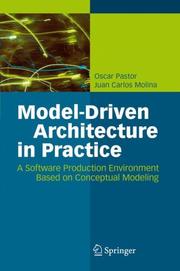
ISBN: 3540718672 9783540718673 364209094X 9786610937967 1280937963 3540718680 Year: 2007 Publisher: Berlin ; New York : Springer,
Abstract | Keywords | Export | Availability | Bookmark
 Loading...
Loading...Choose an application
- Reference Manager
- EndNote
- RefWorks (Direct export to RefWorks)
Formal specification languages, object-oriented methods, CASE tools, component-based software production, agent-oriented, aspect-oriented ... During the last two decades many techniques have been proposed from both research and industry in order to generate a correct software product from a higher-level system specification. Nevertheless, the many failures in achieving this goal have resulted in scepticism when facing any new proposal that offers a "press the button, get all the code" strategy. And now the hype around OMG’s MDA has given a new push to these strategies. Oscar Pastor and Juan Carlos Molina combine a sound theoretical approach based on more than 10 years’ research with industrial strength and practical software development experience. They present a software process based on model transformation technology, thus making the statement "the model is the code" – instead of the common "the code is the model" – finally come true. They clearly explain which conceptual primitives should be present in a system specification, how to use UML to properly represent this subset of basic conceptual constructs, how to identify just those diagrams and modeling constructs that are actually required to create a meaningful conceptual schema, and, finally, how to accomplish the transformation process between the problem space and the solution space. Their approach is fully supported by commercially available tools, and the subsequent software production process is dramatically more efficient than today’s conventional software development processes, saving many man-days of work. For software developers and architects, project managers, and people responsible for quality assurance, this book introduces all the relevant information required to understand and put MDA into industrial practice.
Model-driven software architecture --- Object-oriented methods (Computer science) --- Computer architecture. --- Computer software --- Model-driven software architecture. --- Object-oriented methods (Computer science). --- Development. --- Information Technology --- Software Engineering --- Software engineering. --- Computer aided design. --- Computer simulation. --- Computer science. --- Software Engineering. --- Information Systems Applications (incl. Internet). --- Computer-Aided Engineering (CAD, CAE) and Design. --- Simulation and Modeling. --- Models and Principles. --- Informatics --- Science --- Computer modeling --- Computer models --- Modeling, Computer --- Models, Computer --- Simulation, Computer --- Electromechanical analogies --- Mathematical models --- Simulation methods --- Model-integrated computing --- CAD (Computer-aided design) --- Computer-assisted design --- Computer-aided engineering --- Design --- Computer software engineering --- Engineering --- Application software. --- Computer-aided engineering. --- Computers. --- Automatic computers --- Automatic data processors --- Computer hardware --- Computing machines (Computers) --- Electronic brains --- Electronic calculating-machines --- Electronic computers --- Hardware, Computer --- Computer systems --- Cybernetics --- Machine theory --- Calculators --- Cyberspace --- CAE --- Application computer programs --- Application computer software --- Applications software --- Apps (Computer software) --- Data processing
| Listing 1 - 10 of 28 | << page >> |
Sort by
|

 Search
Search Feedback
Feedback About UniCat
About UniCat  Help
Help News
News